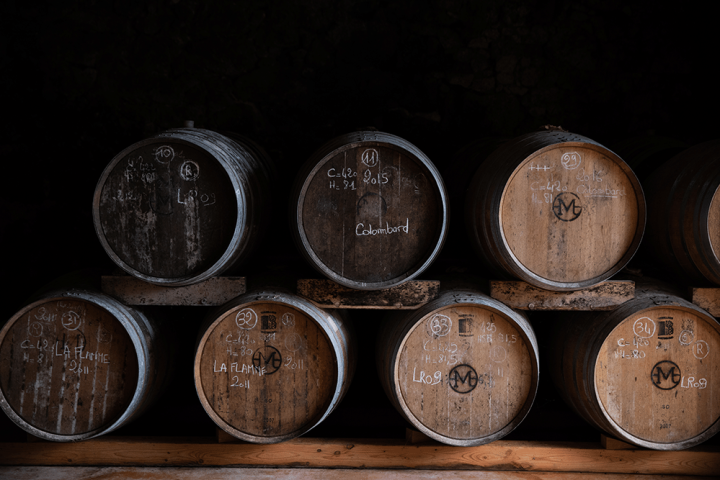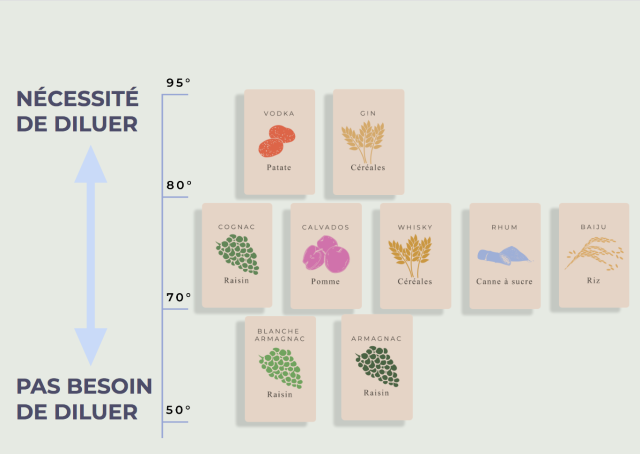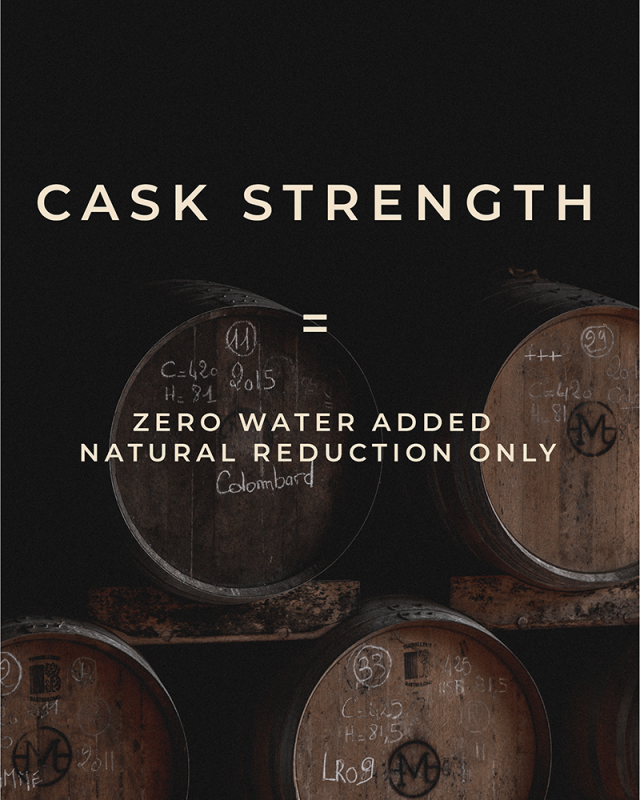
Cask Strength vs Single Cask
WHAT IS "CASK STRENGTH” ?
Most spirits are diluted with water during or after aging to reduce their alcohol content down to 40-45% for bottling and sale.

“Cask strength” is a term that refers to a spirit that is bottled without being diluted with added
water. Nothing is added, and nothing is taken away. The only change in proof happens during
the aging in the cellar, the gentle evaporation from the cask distillers refer to as “The Angels’
Share.” This technique preserves the unique character of the Armagnac. This is the case for La
Flamme® vintages and Château Arton Single Casks.
During their aging, our Unique Pieces, or Single Casks, develop a symbiotic relationship with
the barrel in which they rest. It’s a gentle give-and-take between the spirit and the cask, each
changing the other. This imprint gives the spirit a unique flavor that we seek to enhance and
highlight.

But, how is this possible?
We age our distillate, which we call “eaux-de-vie’, or “water of life,” in our humid cellar. During
aging, the water in the air naturally enters the barrel via the porosity of the wood, allowing our
Armagnacs to be diluted slowly and naturally.
This natural reduction, which we call the Angels’ Share, accounts for only a 0.5% reduction of
alcohol per year. This is a subtle and gentle process, more respectful of aromas than artificial
dilution.
The natural reduction of proof for Armagnac can be achieved in only 10 years because the
Armagnac comes out of the Armagnac alembic at a relatively low proof, around 55% alcohol. It
takes much longer to naturally reduce a Cognac or a Whiskey, which comes out of the still much
higher, at around 72% alcohol. Cellar masters are forced to add water to dilute, a perilous
exercise if one does not want to break the structure and the character of the spirit. Adding water
too quickly can cause volatile aromatics to evaporate and leave the Armagnac forever.
THE "SINGLE CASK", WHAT IS IT?
The “Single Cask” is an Armagnac that comes from a single barrel, a single vintage, and a single grape variety. These are the Single Casks of our collection. We can trace the history of each Single Cask to the plot which saw the growth of its vines and grapes. It is in this spirit that we number the barrels, because, traceability is, for us, a guarantee of excellence and pride.

We have chosen to distill one grape variety at a time, resulting in each cask containing a single variety. This is because each variety has its own aroma and character that we want to highlight, and these unique characteristics will develop further in the cellar. During aging, each cask is monitored individually and tasted regularly in order to select those that will become our Single Cask.
Due to the unique character of the Armagnac still, there is one barrel that is naturally blended. This is the transition barrel, which is split between the two grape varieties. This cask goes into the composition of La Réserve, our signature blend, where the complex aromas of this blend can be balanced by careful blending.
WHY IS THE MAKING-OF OF A BARREL ESSENTIAL?
Because each cask is handmade by a traditional artesian, each has a “flavor” of its own. The choice of wood, the duration and conditions of its drying, and the type of toasting (light, medium or strong) will influence the color and taste of the wood that the Armagnac will take on during its time aging in the cask. The cask is alive! It transmits unique aromas to the eau-de-vie.
Château Arton begins its aging in new, strongly toasted pedunculate oak barrels made by Master Cooper Gilles Bartholomo. For 18 months, the eau-de-vie takes on the taste and color of the wood. The coloring of the juice and the influence of the aromas are rapid because the wood has been strongly toasted. The eau-de-vie is then placed in a older, inert barrel that gives no oak aroma. This is an older barrel (3 years+ of use), where the eau-de-vie continues to age and develop from the effects of micro-oxygenation and the natural dilution of alcohol via evaporation – the Angels’ Share. During this portion of aging, the tannins are refined, and the extraction of the wood no longer takes place.
THE COLOR OF ARMAGNAC
Each Armagnac has a color that characterizes it. Varying from golden to amber, it tells something about its aging process. Coloration is linked to the length of time that the eau-de-vie spends in the young cask, which is a “living” cask capable of transmitting the attributes- particularly color and flavor-of its wood. Further aging in older, neutral casks refines these attributes without adding excessive wood character.

Contrary to what one might think, a very amber color is not necessarily characteristic of very long aging. A young Armagnac in a barrel with a strong toast can be darker than an old Armagnac in a light toast. This is the case of Château Arton. Color does not tell you everything!
There is only one certainty: the longer the spirit stays in a young cask, the stronger the taste and color of the wood will be. But this is not necessarily the path to quality. Château Arton believes that quality lies in the balance between the wood and the eau-de-vie, the living spirit of the vineyard.
ARMAGNACS, TYPOLOGY AND QUALITIES
The quality of an Armagnac is an alchemy that, contrary to popular belief, does not owe all of its exceptional qualities to its age. It is the quality of the liquid itself that is the key. Striving for excellence means focusing on every detail and leaving as little as possible to accident. But, like in all alchemy, there is always a little room left for magic.
HAUT-ARMAGNAC, BAS-ARMAGNAC, TÉNARÈZE, WHAT ARE THE DIFFERENCES?
Armagnac. Haut. Bas. Tenareze. The names are confusing! They are represent three different ways to capture the richness of the Armagnac spirit. Born in Gascony, a province located between the Atlantic, the Pyrenees and the Garonne, Armagnac takes its name from the region from which it comes, a territory recognized as AOC in 1936 which extends over the department of Gers, the east of Landes and the south of Lot-et-Garonne.